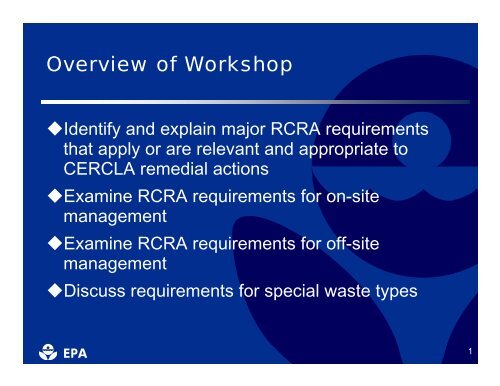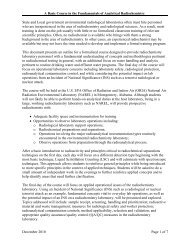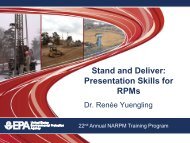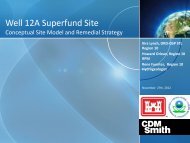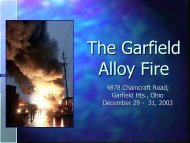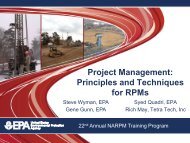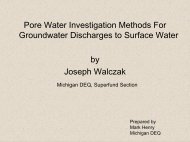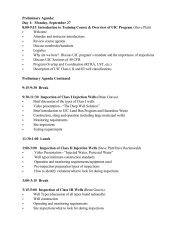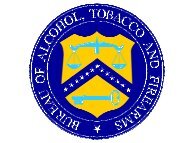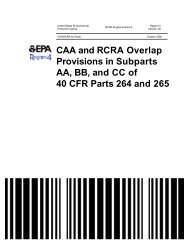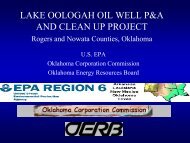Overview of Workshop - EPANARPM.org
Overview of Workshop - EPANARPM.org
Overview of Workshop - EPANARPM.org
Create successful ePaper yourself
Turn your PDF publications into a flip-book with our unique Google optimized e-Paper software.
Statutory Framework <strong>of</strong> RCRA! Amended the Solid Waste Disposal Act! Major amendments have included the:» Hazardous and Solid Waste Amendments <strong>of</strong> 1984(HSWA)» Federal Facilities Compliance Act <strong>of</strong> 1992 (FFCA)» Land Disposal Program Flexibility Act <strong>of</strong> 1996! Includes 10 subtitles; created three major regulatoryprogramsEPA6
Regulatory Framework forImplementing Subtitle C <strong>of</strong> RCRA!Subtitle C provides the statutory framework forthe hazardous waste regulatory program!EPA is authorized to issue regulations onhazardous waste identification, management,and corrective action!Regulations are set forth in 40 CFR Parts 260-279EPA7
Applicability <strong>of</strong> State HazardousWaste Laws and Regulations! States may be delegated authority to implement RCRArequirements» Regulations promulgated under RCRA and HSWAauthorities! If the state is so authorized, the state’s RCRA regulations areapplicable» States may define more wastes as hazardous than EPA» States also may have more stringent waste managementrequirements» States may decline to adopt Federal requirements that areless stringent than existing standards! Other state environmental laws and regulations may beapplicable to non-hazardous wastesEPA8
Hazardous Waste DeterminationUnder RCRA!An issue that almost always must be addressedduring CERCLA responses!A prerequisite for RCRA applicability(continued)EPA9
Hazardous Waste DeterminationUnder RCRA!The basic process involves four steps!Answer three questions first!Be careful <strong>of</strong> words or terms with specialdefinitionsEPA10
RCRA Regulations Used to IdentifyHazardous Waste!Exclusions from definition <strong>of</strong> solid waste!Definition <strong>of</strong> solid waste!Exclusions from definition <strong>of</strong> hazardous waste!Definition <strong>of</strong> hazardous waste!Variances and rulemaking petitionsEPA11
Exclusions From the Definition <strong>of</strong>Solid Waste!Congress and EPA have excluded certainmaterials from regulation under RCRA!A list <strong>of</strong> materials excluded from RCRAregulation is set forth in 40 CFR 261.4(a)EPA12
The Definition <strong>of</strong> Solid Waste40 CFR 261.2!Solid wastes are discarded materials!A discarded material is any material that is:»Abandoned»Recycled»Considered inherently waste-like»A military munition(continued)EPA13
The Definition <strong>of</strong> Solid Waste!A material is abandoned if it is:»Disposed <strong>of</strong>»Burned or incinerated»Accumulated, stored or treated prior to or inlieu <strong>of</strong> abandonment(continued)EPA14
The Definition <strong>of</strong> Solid Waste!A material is a solid waste if it is recycled bybeing:»Used in a manner constituting disposal»Burned for energy recovery»Reclamation»Accumulated speculatively(continued)EPA15
The Definition <strong>of</strong> Solid Waste!Table 1 in 40 CFR 261.2 summarizes theregulatory status <strong>of</strong> recycled materials»Spent material»Sludges»By-products»Scrap metal»Commercial chemicalproducts(continued)EPA16
The Definition <strong>of</strong> Solid Waste!A material is not a solid waste if it is recycled bybeing:»Used or reused as an ingredient»Used as an effective substitute for a product»Used in a closed-loop process!Anyone claiming the above exclusion mustprovide documentationEPA17
Definition <strong>of</strong> Solid WasteCase StudyAn OSC discovers several drums <strong>of</strong> used solvents at a site.The OSC identifies several options for managing the usedsolvents.Option 1: The used solvent is sent to a fuel blending facility.Option 2: The used solvent is sent to a solvent reclamationfacility.Option 3: The used solvent is sent to an autobody shopwhere the owner will use the spent solvent fordegreasing parts instead <strong>of</strong> purchasing productsolvent.For each option, determine if the used solvent is defined asa solid waste under RCRA.(continued)EPA18
Definition <strong>of</strong> Solid WasteCase StudyThe following activities occurred during a CERCLA remedialaction:Action 1: Potentially contaminated soil was excavated andplaced into small piles to facilitate sampling.Action 2: Treated groundwater was stored in an abovegroundtank prior to discharge to POTW.Determine if the materials meet the definition <strong>of</strong> solid wasteunder RCRA.EPA19
Exclusions From the Definition <strong>of</strong>Hazardous Waste!Congress and EPA have excluded certain solidwastes from the definition <strong>of</strong> hazardous waste!A list <strong>of</strong> solid wastes excluded from RCRAregulation is set forth in 40 CFR 261.4(b)EPA20
Definition <strong>of</strong> Hazardous Waste40 CFR 261.3! Includes solid waste that:» Is listed as hazardous waste by EPA (“listed waste”)hazardous» Exhibits any <strong>of</strong> four characteristics <strong>of</strong> hazardous waste(“characteristic hazardous waste”)» Is a mixture <strong>of</strong> solid waste and a listed hazardouswaste (“mixture rule”)» Is derived from the treatment, storage, or disposal <strong>of</strong>other hazardous waste (“derived-from rule”)EPA21
Listed Hazardous Wastes!Wastes from non-specific sources (40 CFR261.31, F-codes)!Wastes from specific sources (40 CFR 261.32,K-codes)!Discarded commercial chemical products (40CFR 261.33, P- and U-codes)(continued)EPA22
Listed Hazardous Wastes!Differences between listed and characteristichazardous wastes!Determination whether a waste is listed atCERCLA sites!Basis for listingwastes!Acutely hazardouswastesEPA23
Listed Hazardous WasteCase StudyThe following materials were encountered during a removalaction:1. Three 55-gallon drums that contain a used solvent. Amaterial safety data sheet (MSDS) indicates that thesolvent contained 60 percent toluene, 35 percentbenzene, and 4 percent methyl ethyl ketone.2. Contaminated soil and debris from the rupture <strong>of</strong> a tankcontaining product aldicarb.Determine if the materials are listed hazardous waste.EPA24
Characteristics <strong>of</strong> HazardousWastes!Ignitability (40 CFR 261.21)!Corrosivity (40 CFR 261.22)!Reactivity (40 CFR 261.23)!Toxicity (40 CFR 261.24)!Determination whether a waste exhibits anycharacteristicEPA25
Ignitability!Liquid with a flash point <strong>of</strong> less than 140°F!Not liquid and capable <strong>of</strong> igniting under standardtemperature and pressure and burns vigorouslyand persistently!Ignitable compressed gas!Oxidizer!RCRA waste code D001EPA26
Corrosivity!Aqueous with pH less than or equal to 2 <strong>org</strong>reater than or equal to 12.5!Liquid that corrodes steel!RCRA waste code D002EPA27
Reactivity!Normally unstable and violent change withoutdetonation!Reacts violently with water!Forms potentially explosive mixtures with water!Generates toxic gases, vapors, or fumes whenmixed with water!Cyanide- or sulfide-bearing waste that generates<strong>of</strong>f-toxic gases, vapors, or fumes when exposedto pH conditions between 2 and 12.5(continued)EPA28
Reactivity!Capable <strong>of</strong> detonation from initiating source orheated confinement!Readily capable <strong>of</strong> detonation, explosivedecomposition, or reaction at standard pressureand temperature!Forbidden, Class A, and Class B explosives!RCRA waste code D003EPA29
Toxicity!Includes those wastes that contain toxicconstituents, such as pesticides, toxic metals,and toxic <strong>org</strong>anics!TCLP is the required test!Constituents in extract must equal or exceedregulatory threshold!For wastes containing less than 0.5 percentfilterable solids - waste itself is the extract!RCRA waste codes D004-D043EPA30
Characteristic WastesCase StudyThe following wastes were generated during a responseaction:Waste 1: Alkaline cleaning solution drained from vats at anabandoned plating shop. The solution had a pH<strong>of</strong> 13.Waste 2: Unused petroleum-based paint thinner. A MSDSindicates the thinner has a flash point <strong>of</strong> 120°F.Waste 3: Ash from coal-fired boilers. The ash may containhigh levels <strong>of</strong> chromium or lead.Determine if the materials are characteristic hazardouswastes.EPA31
Definition <strong>of</strong> Hazardous WasteMixture and Derived-From Rules!Legal history!Mixture rule!Derived-from rule!HWIR exemption levels and other targetedexemptions from the mixture and derived-fromrulesEPA32
Mixture and Derived-From RulesCase StudyThe following activities occur during a CERCLA response:Activity 1: Thirty drums that contain a listed hazardouswaste (F003) are combined with 20 drums thatcontain an ignitable hazardous waste (D001).The bulked waste does not exhibit thecharacteristic <strong>of</strong> ignitability.Activity 2: A listed hazardous waste sludge (F006) iscombined with various residues removed fromvats in a plating line. The bulked waste does notexhibit the toxicity characteristic.Determine if the bulked wastes are hazardous under RCRA.EPA33
The Contained-In Policy!Applies primarily to contaminated environmentalmedia, such as contaminated soils!Occurs on a case-by-case basis!Lacks definitive guidance or regulationsdetermining appropriate contained-in levelsEPA34
RCRA ARARs for On-Site StorageUnits! Common RCRA action-specific ARARs for remedialalternatives involving on-site storage include:» Accumulation time, closure, and other generalrequirements» Containers and tanks» Temporary units» Staging piles» Waste pilesEPA35
Accumulation Time, Closure, andOther General Requirements!Temporary storage <strong>of</strong> waste for less than 90days addressed at 40 CFR 262.34!Only certain units may be used for temporarystorage!Includes general requirements for closure,preparedness and prevention, and labelingEPA36
Containers! Standards are in 40 CFR Parts 264 or 265 Subpart I! Containers must be in good condition, compatible withthe waste, closed during storage, and provided withsecondary containment! Special regulations apply for managing ignitable,reactive, and incompatible wastes! Spilled or leaked waste must be removed as neededEPA37
Tank Systems! Standards are in 40 CFR Parts 264 and 265 Subpart J! Certain tanks are exempted from regulations! Require secondary containment and run-on and run-<strong>of</strong>fcontrols! Must be equipped with spill prevention controls! Must have leak detection system and spill responseprogram! Special requirements apply to ignitable, reactive, andincompatible wastesEPA38
Temporary Unit!Accommodates the non-land-based storage <strong>of</strong>remediation waste!Time <strong>of</strong> operation is limitedEPA39
Staging Pile!A staging pile is a new unit for managingremediation waste created by the HWIR-Mediarule!Waste managed in a staging pile is not subject toLDRs or MTRs!Mixing, sizing, blending,or other physical operationsare allowed, but no“treatment”EPA40
Requirements for Staging Pile!Performance standards»Must facilitate remedy»Must be designed to prevent releases»Must not operate for more than two years»Must be closed properly(continued)EPA41
Requirements for Staging Pile! Factors for design» Length <strong>of</strong> operation» Volume to be stored» Waste characteristics» Potential for releases» Environmental factors at the facility» Potential for exposure! Special provisions for ignitable, reactive, andincompatible wastesEPA42
Waste Piles!Standards are in 40 CFR Parts 264 or 265Subpart L!Waste placed into a waste pile is subject to landdisposal restrictions!Include substantive requirements for liners,leachate collection, run-on and run-<strong>of</strong>f controls,groundwater monitoring, and closureEPA43
RCRA ARARs for On-Site Treatmentand Disposal Units!Potential RCRA action-specific ARARs for:»Combustion and thermal treatmenttechnologies»Stabilization/solidification»Bioremediation»Disposal unitsEPA44
Combustion and ThermalTechnologies! Includes soil vapor extraction, low temperature thermaldesorption, burning in boilers or industrial furnaces, andincineration! Potential RCRA action-specific ARARs! 40 CFR Part 264 Subpart O/40 CFR Part 63 SubpartEEE (incinerators)! 40 CFR Part 266 Subpart H (boilers and industrialfurnaces)! 40 CFR Part 264 Subpart X (miscellaneous units)(continued)EPA45
Combustion and ThermalTechnologies!Technology performance standards»Destruction and removal efficiency»Metals, principal <strong>org</strong>anic hazardousconstituents, dioxin, particulate matter, chlorine»Land Disposal Restriction treatment standards!Operating and monitoring requirements!Management <strong>of</strong> treatment residues!ClosureEPA46
Stabilization and Solidification!In-situ and ex-situ treatment used to reducemobility <strong>of</strong> hazardous constituents in soils,sludges, and other wastes!Potential RCRA action-specific ARARs»Standards for containers, tanks, temporaryunits, or CAMUs»RCRA land disposal restrictions»Final cover, closure and post-closure, andgroundwater monitoringEPA47
Bioremediation!In-situ or ex-situ process that usesmicro<strong>org</strong>anisms to degrade <strong>org</strong>aniccontaminants in soils, solids, or sludge!Potential RCRA action-specific ARARs»Groundwater monitoring»Waste piles, land treatment units, treatmentonlyCAMUsEPA48
Disposal Units! Includes landfills, corrective action management units, orother areas where wastes are left in place! Potential RCRA action-specific ARARs» 40 CFR Part 264 and 265 Subpart N (landfills)» 40 CFR 264.552 (CAMUs)» Subtitle C final cover regulations (40 CFR 264.310 or265.310)» Subtitle D final cover regulations (40 CFR 258.60)» Land disposal restrictions» Closure and post-closure care» Groundwater monitoringEPA49
Area <strong>of</strong> Contamination!Discrete area <strong>of</strong> contamination that equates to asingle RCRA land-based unit!Movement <strong>of</strong> wastes within an AOC does nottrigger LDRs or minimum technologyrequirements (MTRs)!AOC concept is only applicable to remediationwastesEPA50
Corrective Action Management Unit! A special type <strong>of</strong> land-based unit created for themanagement <strong>of</strong> remediation waste! Only certain wastes are eligible for management inCAMUs! Design standards for CAMUs where waste will remainafter closure include:» Liner requirements»Caps» Corrective actionfor any releases(continued)EPA51
Corrective Action Management Unit!Principal hazardous constituents (PHCs) inwastes must meet treatment standards beforeplacement in a CAMU!CAMUs that are used for treatment or storageonly are subject to requirements for staging piles!A CAMU must be designated in an AM or ROD!“Grandfathered” CAMUsEPA52
Differences Between an AOC andCAMU!Waste may be treated ex-situ and placed in aCAMU!A CAMU may be located in an uncontaminatedarea!Wastes may be consolidated in CAMUs fromareas not contiguously contaminated!The recent CAMU rulemaking does not affectuse <strong>of</strong> AOCsEPA53
Pump-and-Treat Remedies!Underground injection <strong>of</strong>groundwater contaminatedwith hazardous waste frequentlyoccurs as part <strong>of</strong> CERCLAresponse actions!Underground injection isdefined as “land disposal”for purposes <strong>of</strong> the LDR program!Section 3020 <strong>of</strong> RCRA addresses theunderground injection <strong>of</strong> hazardous waste in thecontext <strong>of</strong> RCRA and CERCLA cleanups(continued)EPA54
Pump-and-Treat Remedies!Under EPA policy, reinjected groundwater isexempt from compliance with LDRs provided:»It is treated before reinjection (both ex-situ andin-situ)»The cleanup is protective <strong>of</strong> human health andthe environment»The injection is part <strong>of</strong> response action underCERCLA Section 104 or 106 or RCRAcorrective actionEPA55
Land Disposal Restrictions!Purpose <strong>of</strong> the LDRs!Definition <strong>of</strong> land disposal for purposes <strong>of</strong> theLDRs!LDRs “attach” to the hazardous waste at thepoint <strong>of</strong> generation(continued)EPA56
Land Disposal Restrictions!Major regulations involved (40 CFR Part 268):»Identification <strong>of</strong> restricted wastes»Determination <strong>of</strong> treatment standards»Prohibitions against dilution and storage»Compliance with tracking and recordkeepingrequirements»Variances and petitions from the LDRtreatment standardsEPA57
Application <strong>of</strong> LDRsCase StudyThe following activities occurred during a CERCLA remedial action:Action 1: 50 drums <strong>of</strong> a RCRA-listed (F005) spent solvent are sent toan <strong>of</strong>f-site TSDF. It is unknown how long the drums havebeen stored at the site.Action 2: An abandoned impoundment contains sludge that wasdisposed before 1979. The sludge is removed from theimpoundment for disposal and determined to exhibit thecharacteristic <strong>of</strong> toxicity.Action 3: Contaminated soil is excavated near a tank that held aproprietary product containing a mixture <strong>of</strong> various solvents(none <strong>of</strong> the solvents was a sole active ingredient). The soildoes not exhibit any characteristics.Action 4: An impoundment contains a listed hazardous waste that wasdisposed after the effective date <strong>of</strong> LDRs. A proposedalternative is to cap the impoundment with waste in place.Determine whether the RCRA LDRs apply to any <strong>of</strong> the wastes.EPA58
Identification <strong>of</strong> Restricted Wastes!Wastes subject to the LDR program areidentified under 40 CFR Part 268 Subpart C!Wastes subject to the LDR program are referredto as “restricted wastes,” and wastes that cannotbe land disposed are called “prohibited wastes”!Most hazardous wastes are covered under theLDR programEPA59
Treatment Standards!Generators must determine whether the wastemust be treated before it can be land disposed!Definition <strong>of</strong> treatment standard!Treatment standards are established based onBDAT and expressed in several manners!“Treatability groups” and “treatmentsubcategories”!Treatment standards are set forth at 40 CFR Part268 Subpart D(continued)EPA60
Treatment Standards!Universal Treatment Standards (UTS)!Treatments standards for Underlying HazardousConstituents (UHCs)!Alternative treatment standards»Lab packs»Hazardous debris»Contaminated soilsEPA61
Determination <strong>of</strong> TreatmentStandards!Identify each applicable RCRA hazardous wastecode for the waste!Determine the waste’s treatability group,subcategory (if applicable), and alternativetreatment standard (if applicable)!Determine the regulated constituents if the wasteis F001-F005 and F039!Determine if UHCs require treatment forcharacteristic wastesEPA62
LDR Treatment StandardsCase StudyThree 55-gallon drums <strong>of</strong> spent TCE solvent mustbe disposed <strong>of</strong>. The TCE was used to degreasemetal parts at a plating facility.Determine the applicable treatment standard forthe waste.(continued)EPA63
LDR Treatment StandardsCase StudyA 55-gallon drum <strong>of</strong> corrosive liquid requires disposal. Theliquid was sampled and the analytical results are shownbelow:Constituent/Property ValuepH 13Chromium0.5 mg/LLead2 mg/LTotal Organic Carbon >1%Determine the applicable treatment standard for the liquid.EPA64
Alternative Treatment Standardsfor Contaminated Soil!Creates a new treatability group: contaminatedsoils!Provides the option <strong>of</strong> meeting LDR standardsfor contaminated soil versus the standardestablished for existing industrial wastes!Treatment standard requires that theconcentrations <strong>of</strong> hazardous constituents bereduced by 90 percent, capped at 10 times theUTS(continued)EPA65
Alternative Treatment Standardsfor Contaminated Soil!Measurement <strong>of</strong> the 90 percent reduction mustbe consistent with UTS!A treatability variance for soils is not required!Treatment required for UHCs present at 10 timestheir respective UTSEPA66
Prohibitions Against Dilution andStorage!Dilution prohibition (40 CFR 268.3)!Storage prohibition (40 CFR 268 Subpart E)EPA67
Variances and Petitions From theLDR Treatment Standards!Treatability variance!Alternative treatment method petition!No-migration petition!DelistingEPA68
Treatability Variance!Allowance for treatability variance from treatmentstandard!Requirement that waste be physically orchemically different!Applicability to waste mixtures, derived-fromresidues, and environmental mediaEPA69
Tips on Treatability Variances! Authority to grant a treatability variance is delegated toEPA regional <strong>of</strong>fices! No public comment period is required for removalactions, but the variance should be included in theAdministrative Record! A variance can be a stand-alone document or can beincluded in an Action Memorandum or Record <strong>of</strong>Decision! A concurrence memorandum issued by the RCRAprogram usually is requiredEPA70
Special Waste Types! PCBs! Dioxins! Used oil! Radioactive waste! Mixed waste! Laboratory chemicals! Asbestos! Gas cylinders! Shock-sensitive orreactive waste! Biological waste! Mining waste! Hazardous debris! Universal waste! IDW! UXO and munitions! Empty drumsEPA71
Polychlorinated Biphenyls! Origins <strong>of</strong> the waste: transformers, capacitors, orhydraulic fluid! Regulatory status: TSCA (40 CFR part 761)! Cleanup levels: OSWER Dir. No. 9355.4-01, PCB spillcleanup policy under TSCA and the June 1998 PCBregulations under TSCA! Off-site treatment and disposal requirements:incineration or disposal in TSCA or RCRA Subtitle Clandfill with special manifesting requirements! Options for on-site treatment and disposal: separation,incineration, and stabilizationEPA72
PCBsCase StudyThe AM cites TSCA as an ARAR and states that the PCBoil in the transformers will be incinerated and that PCBcontaminatedsoil will be disposed <strong>of</strong> in a chemical wastelandfill. The state representative for the site claims that theTSCA anti-dilution provisions set forth at 40 CFR 761.1(b)require that PCB contamination be treated and disposed <strong>of</strong>on the basis <strong>of</strong> the original form <strong>of</strong> the PCBs. He says thatsite records show clearly that the PCBs in the soil originatedfrom spilled transformer oil and therefore, in order to complywith the ARAR, the PCB-contaminated soil also must beincinerated.What is your response?EPA73
Dioxins! Origins <strong>of</strong> the waste: chlorinated phenols, incineration <strong>of</strong>chlorine-based solvents, and wood treatment! Regulatory status: RCRA (40 CFR Part 261)! Cleanup levels: risk-based tetrachlorodibenzo-p-dioxin(TCDD) equivalents! Off-site treatment and disposal requirements:incineration to meet RCRA LDRs (40 CFR Part 268)! Options for on-site treatment and storage: incineration,bioremediation, or storageEPA74
Used Oil!Origins <strong>of</strong> the waste: engine maintenance, metalmachining, rerefining, and leaking USTs!Regulatory status: RCRA (40 CFR Part 279),TSCA (40 CFR 761.20(e))!Cleanup levels: risk-based!Off-site treatment and disposal requirements:recycling or energy recovery subject to RCRA!Option for on-site treatment and disposal:biological treatment or MNAEPA75
Radioactive Waste! Origins <strong>of</strong> the waste: radium from painting, mining, orillegal disposal! Regulatory status: the Atomic Energy Act <strong>of</strong> 1954 (AEA)and requirements imposed by the Nuclear RegulatoryCommission (NRC)! Cleanup levels: risk-based! Off-site treatment and disposal requirements: disposalsubject to NRC and transportation subject to NRC andDOT! Options for on-site treatment and disposal: separation,stabilization, or land disposalEPA76
Mixed Waste! Origins <strong>of</strong> the waste: DOE, DoD, and commercialfacilities! Regulatory status: RCRA, AEA, and NRC (10 CFR Parts20-71)! Cleanup levels: risk-based! Off-site treatment and disposal requirements: disposalsubject to both RCRA and NRC unless conditionalexemption criteria are met! Option for on-site treatment and disposal: combination <strong>of</strong>treatment technologies or disposal in landfill that meetsRCRA and NRC requirementsEPA77
Laboratory Chemicals!Origins <strong>of</strong> the waste: industrial laboratories!Regulatory status: RCRA (40 CFR Part 261)!Cleanup level: removal <strong>of</strong> chemicals!Off-site treatment and disposal requirements:disposal or recycling and reuse subject to RCRAand DOT!Option for on-site treatment and disposal:characterizing, packaging, and disposal by aTSDFEPA78
Asbestos! Origins <strong>of</strong> the waste: building, pipe, and tank insulation! Regulatory status: National Emissions Standard forHazardous Air Pollutants (NESHAPs) under the CAA andTSCA! Cleanup level: NESHAPs! Off-site treatment and disposal requirements: disposalregulated under NESHAPs (40 CFR Part 61);transportation regulated under DOT! Option for on-site treatment and disposal: land disposalEPA79
Gas Cylinders! Origins <strong>of</strong> the waste: manufacturing! Regulatory status: RCRA (40 CFR Part 261), OSHA, andDOT! Cleanup level: removal! Off-site treatment and disposal requirements: disposalregulated under RCRA; transportation regulated underDOT! Options for on-site treatment and disposal: venting inertgases, chemical treatment <strong>of</strong> toxic gases, or detonationEPA80
Shock-Sensitive or Reactive Wastes!Origins <strong>of</strong> the waste: laboratories andmanufacturing operations!Regulatory status: RCRA (40 CFR Part 261)!Cleanup level: removal!Off-site treatment and disposal requirements:disposal and treatment regulated under RCRA!Options for on-site treatment and disposal:detonation or slow mixingEPA81
Biological Wastes! Origins <strong>of</strong> the waste: illegal disposal <strong>of</strong> medical waste,animal carcasses, terrorist acts, and wastes from floods! Regulatory status: state regulations! Cleanup level: removal or decontamination! Off-site treatment and disposal requirement: incinerationor disposal in landfills subject to state regulations! Options for on-site treatment and disposal: <strong>of</strong>f-sitehandling recommendedEPA82
Mining Wastes! Origins <strong>of</strong> the waste: extraction, beneficiation, andprocessing <strong>of</strong> ores and minerals! Regulatory status: RCRA (40 CFR Part 261) and stateregulations! Cleanup level: risk-based! Off-site treatment and disposal requirements: disposalregulated under RCRA or special state regulations! Options for on-site treatment and disposal: consolidationand containment, solidification and stabilization, andseparation <strong>of</strong> metalsEPA83
Hazardous Debris! Origins <strong>of</strong> the waste: manufacturing facilities andchemical processing facilities! Regulatory status: RCRA (40 CFR Part 268)! Cleanup level: removal and compliance with RCRA LDRstandards (40 CFR 268.45)! Off-site treatment and disposal requirements: treatmentand disposal regulated under RCRA! Options for on-site treatment and disposal: treatmentmethods listed in the alternative treatment standards forhazardous debrisEPA84
Hazardous DebrisCase StudyAn OSC is working on a site at which metal debrisis present (tanks that were cut up by the formerowner <strong>of</strong> the site). The debris is contaminated withtar residue from the production <strong>of</strong> coke (RCRAhazardous waste code K142). An extractiontechnology is proposed to treat the debris.To what level must the debris be treated?EPA85
Universal Wastes! Origins <strong>of</strong> the waste: batteries, pesticides, thermostats,and lamps! Regulatory status: RCRA (40 CFR Part 273), DOT, andFIFRA! Cleanup levels: recycling and reclamation or <strong>of</strong>f-sitedisposal! Off-site treatment and disposal requirements: recycle,reclamation, or disposal with shipment <strong>of</strong> waste todestination facilities subject to 40 CFR Part 273! Options for on-site treatment and disposal: interimstorage that meets substantive standards at 40 CFR Part273EPA86
Investigation-Derived Wastes! Origins <strong>of</strong> the waste: CERCLA field activities! Regulatory status: RCRA, CWA, CAA, TSCA, and statelaws! Cleanup levels: consistent with the final remedy for thesite! Off-site treatment and disposal requirements: consistentwith the disposal <strong>of</strong> other similar removal wastes at thesite! Options for on-site treatment and disposal: returnindigenous IDW to the source or containerize IDW untilthe final remedy is implementedEPA87
UXO and Munitions! Origins <strong>of</strong> the waste: Formerly Used Defense Sites(FUDS), ordnance depots, ammunition plants, scrapyards, Base Realignment and Closure (BRAC) facilities! Regulatory status: CERCLA, DERP, RCRA, and DoDregulations! Cleanup levels: UXO Management Principles and 40CFR Part 264 Subpart X! Off-site treatment and disposal requirements: RCRAMilitary Munitions Rule, 40 CFR Part 264 Subpart X, andDoD regulations (DDESB)! Options for on-site treatment and disposal: EOD andOB/OD for UXO, various technologies for contaminatedsoils and groundwaterEPA88
Empty Drums! Origins <strong>of</strong> the waste: barrel recyclers and chemicalfacilities and distributors! Regulatory status: RCRA! Cleanup levels: RCRA empty container rule (40 CFR261.7) or removal! Off-site treatment and disposal requirements: disposalsubject to RCRA, recycling, or reclamation! Options for on-site treatment and disposal: interimstorage, decontamination, or disposalEPA89
Off-Site Treatment and Disposal! ARARs for <strong>of</strong>f-site actions! Selecting an appropriate TSDF! Approval process! Preparing a waste pr<strong>of</strong>ile! Modes <strong>of</strong> transportation! DOT requirements for transporting hazardous materials» Pre-transport requirements under RCRA» Transportation security plans! Hazardous waste manifest and RCRA LDR trackingrequirementsEPA90
ARARs for Off-site Action!Federal requirements!State requirements!Local requirementsEPA91
Selecting an Appropriate TSDF!Identify TSDFs that accept the waste stream!Resources available for identifying TSDFs»RCRAInfo (formerly RCRIS and BRS)»Commercial services!Check compliance status <strong>of</strong> the TSDFs(CERCLA Off-Site Rule at 40 CFR 300.440)EPA92
Approval Process!Prepare waste pr<strong>of</strong>ile or waste characterizationreport!Submit waste pr<strong>of</strong>iles to TSDFs in compliancewith Off-Site Rule!Assess evaluation factors!Schedule disposal <strong>of</strong> wasteEPA93
Elements <strong>of</strong> a Waste Pr<strong>of</strong>ile! Waste pr<strong>of</strong>ile or waste characterization report! Elements <strong>of</strong> a waste pr<strong>of</strong>ile» Generator information» Waste information» Regulatory information» Chemical composition» Physical characteristics» Toxicity characteristics» Shipping and handlinginformation» Generator certificationEPA94
Practical Considerations WhenCompleting a Waste Pr<strong>of</strong>ile!Tailoring information to the treatment anddisposal option!Estimating concentrations <strong>of</strong> analytes!Using ranges <strong>of</strong> concentrationsEPA95
Modes <strong>of</strong> Transportation! Selection <strong>of</strong> type <strong>of</strong> transportation for waste! Types <strong>of</strong> transportation» Dump trailers» Roll-<strong>of</strong>f containers» Box van trailers» Flat-bed trailers» Bulk liquid haulers»Rail cars» Vacuum trailers» Insulated trailers» Overseas bargesEPA96
Rail Shipments! Advantages» Large capacity» Ease <strong>of</strong> loading» Electronic tracking<strong>of</strong> shipment» Cost-effectiveness! Disadvantages» Unavailability» InaccessibilityEPA97
DOT Requirements for TransportingHazardous Materials!Hazardous Materials Regulations (HMR) governtransportation <strong>of</strong> hazardous materials (49 CFRparts 100-185)!Definition <strong>of</strong> hazardous material!HMR requires information to communicatehazards during transportation»Hazardous Materials Table (HMT) at 49 CFR172.101 is critical to complianceEPA98
Information in the HMT(49 CFR 172.101)!Proper shipping name!ID number!Hazard class!Packing group!Labeling and markings!Restrictions and limitationsEPA99
Proper Shipping Names Under DOT! Hazardous materials are assigned proper shippingnames in the HMT! The proper shipping name must be used on hazardouswaste manifests or DOT shipping papers! Examples <strong>of</strong> proper shipping names for hazardouswastes are:» Waste flammable liquids, n.o.s.» Waste flammable liquids,corrosive,n.o.s.(ethanol, sodium hydroxide)» Waste methaneEPA100
DOT Shipping NamesCase StudyThe following materials are sent <strong>of</strong>f-site for disposalduring a removal action:»Spent solvent mixture containing toluene,xylenes, and benzene (F003 and F005)»Contaminated soil that exhibits the toxicitycharacteristic for arsenic (D004)»Used oilDetermine the proper DOT shipping name.EPA101
Hazard Classes Under DOT! Class 1 - explosives! Class 2 - gases! Class 3 - flammable liquids! Class 4 - flammable solids! Class 5 - oxidizing substances and <strong>org</strong>anic peroxides! Class 6 - toxic (poisonous) and infectious substances! Class 7 - radioactive material! Class 8 - corrosives! Class 9 - miscellaneous dangerous goodsEPA102
Packing Groups Under DOT!Packing groups»Group I»Group II»Group III!Criteria for packing groupsEPA103
Placards Under DOT! Placard colors, symbols, labels, and numbers» Flammables: red» Explosives: orange» Nonflammable gases: green» Corrosives: black and white» Poisons: black and white» Oxidizers: yellow! Exceptions to placarding requirementsEPA104
Label and Marking Requirements forHazardous Waste Containers UnderDOT!Label information required!Markings requiredEPA105
RCRA Regulations That Apply to Off-Site Transportation <strong>of</strong> HazardousWaste!Pre-transport requirements»Placarding, labeling, and marking!Hazardous waste manifest!EPA identification numbers!LDR tracking requirementsEPA106
Hazardous Waste Manifest!Manifest is required for <strong>of</strong>f-site transportation <strong>of</strong>hazardous waste»EPA ID numbers are necessary»State hazardous waste manifest may berequired!Selection <strong>of</strong> the appropriatemanifest: Federal or state?!Definition <strong>of</strong> “<strong>of</strong>f-site”EPA107
RCRA Manifest SystemTransporter• Signs and dates manifest• Gives copy <strong>of</strong> manifest to generator• Obtains TSD facility signature and date<strong>of</strong> acceptance• Keeps one copy <strong>of</strong> manifest• Gives TSD facility remaining copies <strong>of</strong>manifest (40 CFR 263.20)Generator• Initiates manifest• Signs manifest (certification)• Obtains transporter’ssignature anddate <strong>of</strong> acceptance• Keeps one copy <strong>of</strong>manifest• Gives transporter remaining copies <strong>of</strong>manifest (40 CFR 262.23)TSD Facility• Completes manifest• Signs and datesmanifest• Notes manifestdiscrepancies• Gives copy <strong>of</strong> manifestto transporter• Sends copy <strong>of</strong> signedmanifest to generatorwithin 30 days• Keeps one copy <strong>of</strong>manifest (40 CFR264.71 or 265.71)EPA108
LDR Tracking Requirements!Restricted wastes require the followingdocumentation:»One-time LDR notification (with initialshipment) if waste does not meet treatmentstandards»One-time notice and certification if wastemeets treatment standards»Waste analysis information (when available)(continued)EPA109
LDR Tracking Requirements!New notifications or certifications must be sent ifthe waste or designated facility changes!Tracking requirements have been established forother shipping and waste scenariosEPA110
Transportation Security Plans!In response to 9-11, DOT issued regulationsconcerning security <strong>of</strong> transportation <strong>of</strong>hazardous materials!Persons who <strong>of</strong>fer for transportation or transportcertain hazardous materials must:»Develop a transportation security plan»Implement the plan!Approval <strong>of</strong> plansEPA111
Hazardous Materials Subject toSecurity Plans! Class 7 (radioactive) material! Greater than 55 gallons <strong>of</strong> a Division 1.1, 1.2, or 1.3 explosivematerial! Greater than 1 L per package <strong>of</strong> a material poisonous by inhalation(Hazard Zone A)! Hazardous material in bulk packaging having capacity equal <strong>org</strong>reater than 3,500 gallons liquids or gases <strong>of</strong> 468 cubic feet forsolids! Hazardous material in bulk packaging <strong>of</strong> 5,000 pounds gross weightor more <strong>of</strong> one class <strong>of</strong> hazardous materials for which placarding isrequired! Select toxin agent or toxin regulated by CDC under 42 CFR 73! A shipment that requires placarding under 49 CFR Part 172 SubpartFEPA112
Components <strong>of</strong> a Security Plan!Personnel security!Unauthorized access!En route securityEPA113


